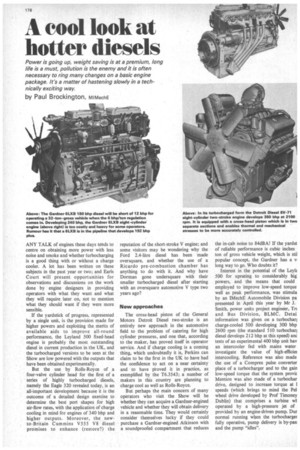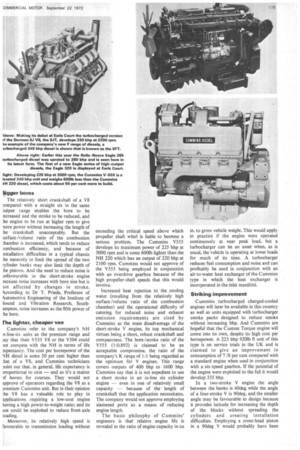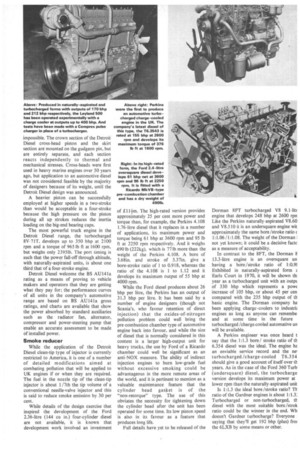A cool look at hotter diesels
Page 178

Page 179

Page 180

If you've noticed an error in this article please click here to report it so we can fix it.
Power is going up, weight saving is at a premium, long life is a must, pollution is the enemy and it/s often necessary to ring many changes on a basic engine package. It's a matter of hastening slowly in a technically exciting way.
by Paul Brockington, MIMechE
ANY TALK of engines these days tends to centre on obtaining more power with less noise and smoke and whether turbocharging is a good thing with or without a charge cooler. A lot has been written on these subjects in the past year or two; and Earls Court will present opportunities for observations and discussions on the work done by engine designers in providing operators with what they want and what they will require later on, not to mention what they should want if they were more sensible.
If the yardstick of progress, represented by a single unit, is the provision made for higher powers and exploiting the merits of available aids to improve all-round performance, the Leyland 500 fixed-head engine is probably the most outstanding diesel in current production in the UK, and the turbocharged versions to be seen at the Show are low powered with the outputs that have been obtained experimentally.
But the use by Rolls-Royce of a four-valve cylinder head for the first of a series of highly turbocharged diesels, namely the Eagle 320 revealed today, is an all-important development because it is the outcome of a detailed design exercise to determine the best port shapes for high air-flow rates, with the application of charge cooling in mind for engines of 340 bhp and higher outputs. Moreover, the newto-Britain Cummins V555 V8 diesel promises to enhance (restore?) the reputation of the short-stroke V engine; and some visitors may be wondering why the Ford 2.4-litre diesel has been made oversquare, and whether the use of a Ricardo pre-combustion chamber has anything to do with it. And why have Dorman gone undersquare with their smaller turbocharged diesel after starting with an oversquare automotive V type two years ago?
New approaches The cross-head piston of the General Motors Detroit Diesel two-stroke is an entirely new approach in the automotive field to the problem of catering for high cylinder pressures, and one that, according to the maker, has proved itself in operator service. And if charge cooling is a coming thing, which undoubtedly it is, Perkins can claim to be the first in the UK to have had the confidence to act on a near certainty and to have proved it in practice, as exemplified by the T6.3543; a number of makers in this country are planning to charge cool as well as Rolls-Royce.
But perhaps the main concern of many operators who visit the Show will be whether they can acquire a Gardner-engined vehicle and whether they will obtain delivery in a reasonable time. They would certainly consider themselves lucky if they could purchase a Gardner-engined Atkinson with a soundproofed compartment that reduces the in-cab noise to 84dBA! If the yardst of reliable performance is cubic inches ton of gross vehicle weight, which is stil popular concept, the Gardner has a v long way to go. Who doubts it?
Interest in the potential of the Leyle 500 for uprating to considerably hig powers, and the means that could employed to improve low-speed torque well as peak performance, was stimula by an IMechE Automobile Division pa presented in April this year by Mr J. Smith, power units project engineer. Tri and Bus Division, BLMC. Detai information was given on a turbocharl charge-cooled 500 developing 300 bhp 2600 rpm (the standard 510 turbocharl diesel develops 212 bhp at this speed) anc tests of an experimental 400 bhp unit hay an intercooler fed with mains water investigate the value of high-efficier intercooling. Reference was also made the use of a Comprex pulse converter place of a turbocharger and to the gain low-speed torque that the system provic Mention was also made of a turbochar drive, designed to increase torque at 1 speeds (which brings to mind the Pei wheel drive developed by Prof Timoney Dublin) that comprises a turbine wE operated by a high-pressure jet of provided by an engine-driven pump. Dur normal running when the turbocharger fully operative, pump delivery is by-pas: and the pump "idles".
digger bores
The relatively short crankshaft of a V8 ;ompared with a straight six in the• same putput range enables the bore to be ncreased and the stroke to be reduced, and he engine to be run at higher rpm to give tore power without increasing the length of he crankshaft unacceptably. But the surface /volume ratio of the combustion 7.hamber is increased, which tends to reduce mmbustion efficiency, and because of nstallation difficulties in a typical chassis .he necessity to limit the spread of the two ;ylinder banks may also limit the depth of h e pistons. And the need to reduce noise is anfavourable to the short-stroke engine Pecause noise increases with bore size but is lot affected by changes in stroke. kccording to Dr T. Priede, Professor of kutomotive Engineering of the Institute of 3ound and Vibration Research, Southampton, noise increases as the fifth power of he bore.
rhe lighter, cheaper vee Cummins refer to the company's NH n-line-six units as the premium range and ;ay that their V555 V8 or the V504 could lot compete with the NH in terms of life !.xpectancy. The cost per horsepower of the NH diesel is some 50 per cent higher than .hat of a V8, and Cummins technicians point out that, in general, life expectancy is proportional to cost — and so it's a matter pf horses for courses. They would not approve of operators regarding the V8 as a premium Cummins unit. But in their opinion
h e V8 has a valuable role to play in applications requiring a low-cost engine naving a high power-to-weight ratio; and its use could be exploited to reduce front-axle Loading.
Moreover, its relatively high speed is Favourable to transmission loading without exceeding the critical speed above which propeller shaft whirl is liable to become a serious problem. The Cummins V555 develops its maximum power of 225 bhp at 3000 rpm and is some 600lb lighter than the NH 220 which has an output of 220 bhp at 2100 rpm. Cummins would not approve of the V555 being employed in conjunction with an overdrive gearbox because of the high propeller-shaft speeds that this would involve.
Increased heat rejection to the cooling water (resulting from the relatively high surfate /volume ratio of the combustion chamber) and the operational difficulty of catering for reduced noise and exhaust emission requirements are cited by Cummins as the main disadvantage of the short-stroke V engine, its top mechanical virtues being a short, robust crankshaft and compactness. The bore /stroke ratio of the V555 (1:0.892) is claimed to be an acceptable compromise, the ratio of the company's K range of 1:1 being regarded as the optimum for V engines. This range covers outputs of 400 bhp to 1600 bhp. Cummins say that it is not expedient to use a short stroke in an in-line six cylinder engine — even in one of relatively small capacity — because of the length of crankshaft that the application necessitates. The company would not approve employing siamesed ports as a means of reducing engine length.
The basic philosphy of Cummins' engineers is that relative engine life is revealed in the ratio of engine capacity in Cu in. to gross vehicle weight. This would apply in practice if the engine were operated continuously at near peak load, but a turbocharger can be an asset when, as is usual, the vehicle is operating at lower loads for much of its time. A turbocharger reduces fuel consumption and noise and can profitably be used in conjunction with an air-to-water heat exchanger of the Cummins type in which the heat exchanger is incorporated in the inlet manifold.
Striking improvement
Cummins turbocharged charged-cooled engines will later be available in this country as well as units equipped with turbocharger smoke packs designed to reduce smoke without increasing bhp. And Cummins are hopeful that the Custom Torque engine will come into its own, despite its high cost per horsepower. A 225 bhp 9201b ft unit of this type is on service trials in the UK and is claimed to give an improvement in consumption rofi /8 per cent compared with a standard engine when used in conjunction with a six-speed gearbox. If the potential of the engine were exploited to the full it would develop 335 bhp.
In a two-stroke V engine the angle between the banks is 60deg while the angle of a four-stroke V is 90deg, and the smaller angle may be favourable to design because it provides latitude for increasing the depth of the blocks without spreading the cylinders and creating installation difficulties. Employing a cross-head piston in a 90deg V would probably have been impossible. The crown section of the Detroit Diesel cross-head piston and the skirt section are mounted on the gudgeon pin, but are entirely separate, and each section reacts independently to thermal and mechanical stresses. Cross-heads were first used in heavy marine engines over 50 years ago, but application to an automotive diesel was not considered feasible by the majority of designers because of its weight, until the Detroit Diesel design was announced.
A heavier piston can be successfully employed at higher speeds in a two-stroke than would be acceptable in a four-stroke because the high pressure on the piston during all up strokes reduces the inertia loading on the big-end bearing caps.
The most powerful truck engine in the Detroit Diesel range, the turbocharged 8V-71T. develops up to 350 bhp at 2100 rpm and a torque of 965 lb ft at 1600 rpm, but weighs only 23951b. The port timing is such that the power fall-off through altitude, with naturally-aspirated units, is about one third that of a four-stroke engine.
Detroit Diesel welcome the BS AU141a rating as a means of proving to vehicle makers and operators that they are getting what they pay for; the performance curves of all units in the company's automotive range are based on BS AU141a gross ratings, and charts are available that show the power absorbed by standard auxiliaries such as the radiator fan, alternator, compressor and power-steering pump that enable an accurate assessment to be made of installed power.
Smoke reducer
While the application of the Detroit Diesel clean-tip type of injector is currently restricted to America, it is one of a number of detailed modifications aimed at combating pollution that will be applied to UK engines if or when they are required. The fuel in the nozzle tip of the clean-tip injector is about 1/7th the tip volume of a conventional needle-valve injector and this is said to reduce smoke emission by 30 per cent.
While details of the design exercise that inspired the development of the Ford 2.36-litre (144 cu four-cylinder diesel are not available, it is known that development work involved an investment
of El 1.4m. The high-rated version provides approximately 25 per cent more power and torque than, for example, the Perkins 4.108 1.76-litre diesel that it replaces in a number of applications, its maximum power and torque being 61 bhp at 3600 rpm and 95 lb ft at 2250 rpm respectively. And it weighs 490 lb (222kg), which is 77 lb more than the weight of the Perkins 4.108. A bore of 3.68in. and stroke of 3.37in. give a bore-stroke ratio of Ito 0.918, whereas the ratio of the 4.108 is 1 to 1.12 and it develops its maximum output of 55 bhp at 4000 rpm.
While the Ford diesel produces about 26 bhp per litre, the Perkins has an output of 31.3 bhp per litre. It has been said by a number of engine designers (though not Scania's, who favour retention of direct injection) that the oxides-of-nitrogen pollution problem could well bring the pre-combustion chamber type of automotive engine back into favour, and while the size of diesel that is normally considered in this context is a larger high-output unit for heavy trucks, the use by Ford of a Ricardo chamber could well be significant as an anti-NOX measure. The ability of indirect injection engines to burn low-grade fuel without excessive smoking could be advantageous in the more remote areas of the world, and it is pertinent to mention as a valuable maintenance feature that the cylinder head gasket is of the "non-retorque" type. The use of this obviates the necessity for tightening down the cylinder head after the unit has been operated for some time. Its low piston speed is also in its favour as a feature that produces long life.
Full details have yet to be released of the Dorman 8FT turbocharged V8 9.1-litt engine that develops 248 bhp at 2600 rpn Like the Perkins naturally-aspirated V8.60 and V8.510 it is an undersquare engine wit approximately the same bore/stroke ratio c 1:1.06 /1:1.08. The weight of the Dorman i not yet known; it could be a decisive factc as a measure of acceptability.
In contrast to the 8FT, the Dorman 8 13.3-litre engine is an oversquare un having a bore/stroke ratio of 1:0.9/ Exhibited in naturally-aspirated form k Earls Court in 1970, it will be shown tit year as a turbocharged unit with an "outpt of 330 bhp which represents a powt increase of 105 bhp, or about 45 per cen compared with the 235 bhp output of th basic engine. The Dorman company ha been applying charge-coolers to industri; engines as long as anyone can remembe and at some time in the future turbocharged /charge-cooled automative un will be available.
A Perkins engineer was once heard t say that the 1:1.3 bore/ stroke ratio of th 6.354 diesel was the ideal. The engine ha an enviable service record and the ne, turbochargetl/charge-cooled T6.354 should give a good account of itself over th years. As in the case of the Ford 360 Turb (undersquare) diesel, the turbocharge version develops its maximum power at lower rpm than the naturally-aspirated unit Is 1:1.3 the ideal bore/stroke ratio? Th ratio of the Gardner engines is about 1:1.3: Turbocharged or non-turbocharged, th diesel with the most suitable bore/strok ratio could be the winner in the end. Wh doesn't Gardner turbocharge? Everyone saying that they'll get 192 bhp (plus) frot the 6LXB by some means or other.
































































































































































































































































































































































































































































































































